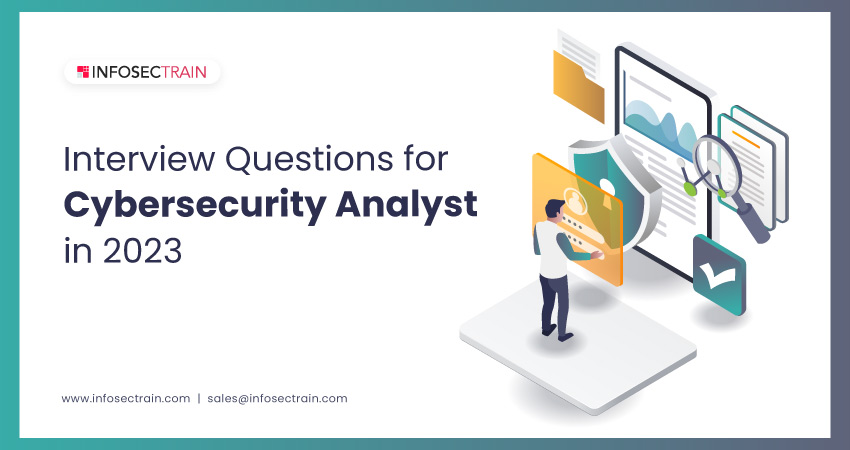Interview Questions for Cybersecurity Analyst in 2023
Our world is flooded with devices that can connect to the internet, and we can easily access many different services with just a simple click. Businesses have benefited from the evolving IT, which has made their journey smoother. However, with these developments come others who lurk behind the technologies for malicious purposes. These cybercriminals are growing more brilliant, and their strategies are becoming more sophisticated. Protecting IT networks and infrastructure from cyberattacks, unauthorized access, and other cybercrimes is the primary responsibility of Cybersecurity Analysts, who are frequently the first line of defense against cybercrime. You can use the questions presented in this article to help you get equipped for the Cybersecurity Analyst interview in 2023.

Cybersecurity Analyst Interview Questions and Answers for 2023:
Question 1: What three pillars underpin information security?
Answer: The three pillars of information security are:
- Confidentiality: This refers to the protection of sensitive information from unauthorized access, disclosure, or exposure. Confidentiality ensures that only authorized individuals or systems can access or view the information and that it remains protected even if it is accidentally or intentionally shared or stolen.
- Integrity: This refers to the protection of information from unauthorized modification or destruction. Integrity ensures that the information remains accurate, complete, and unaltered and that any changes made to it are authorized and traceable.
- Availability: This refers to the accessibility of information to authorized individuals or systems when it is needed. Availability ensures that the information is not blocked, destroyed, or otherwise made unavailable and that it remains accessible even in the event of system failures, disasters, or attacks.
Question 2: What requirements must be met to establish a LAN?
Answer: The following are the requirements to establish a LAN:
- Workstations: Computer, laptop, mobile phones, etc.
- Network devices: Router, switch, modem
- Cables: Ethernet cables, wires for connecting other devices
- Sharing resources: Printers, disk drives, etc.
- Internet connection: Wi-Fi
Question 3: What is the role of AI in cybersecurity?
Answer: As businesses use the advantages of AI-based solutions to detect threats better and safeguard their IT systems and data, therefore, AI plays an increasingly significant role in cybersecurity.
Question 4: What are the steps in the threat intelligence lifecycle?
Answer: The following are the steps in the threat intelligence lifecycle:
- Direction
- Collection
- Processing
- Analysis
- Dissemination
- Feedback
Question 5: Mention various threat detection tools that you can use.
Answer: Some of the threat detection tools are:
- Splunk
- SolarWinds
- CrowdStrike
- Secret Scanner
Question 6: What is the role of a Cybersecurity Analyst?
Answer: A Cybersecurity Analyst is a qualified cyber expert with a focus on network and IT infrastructure security. The following are the responsibilities of Cybersecurity Analysts:
- They investigate security breaches.
- They install and operate security software.
- They find vulnerabilities.
- They monitor systems and networks for security threats and vulnerabilities.
- They take preventative action against cybersecurity threats
- They stay current with the most recent advancements in technology and security.
- They evaluate emerging cybersecurity threats.
Question 7: What is an SSL certificate?
Answer: A CA issues an SSL certificate to an organization, and the domain or website that bears that certificate confirms that a reliable third party has verified the organization’s identity.
Question 8: What is a Cyber Kill Chain?
Answer: The Cyber Kill Chain is a technique for tracking the progression of a cyberattack from the initial phases of reconnaissance through the exfiltration of data. It is a framework for identifying and preventing cyber intrusion activities. There are seven phases in the Cyber Kill Chain:
- Reconnaissance
- Weaponization
- Delivery
- Exploitation
- Installation
- Command and Control (C2)
- Actions on Objectives
Question 9: Explain DHCP.
Answer: The Dynamic Host Configuration Protocol (DHCP) is a network management protocol that automates the configuration of devices on IP networks, enabling them to use network services like DNS, NTP, and any UDP or TCP-based communication protocol.
Question 10: Describe ways to authenticate someone.
Answer: The following are the ways to authenticate someone:
- Something you know (knowledge factor): It proves identities by using some information you store in your memory and may access when necessary, like a PIN.
- Something you have (possession factor): It proves identities based on the information you can carry, like your ID.
- Something you are (inherence factor): It proves identities using information that is unique to you, such as your biometrics.
- Something you do (behavior factor): It verifies identities by observing user actions like picture passwords.
- Somewhere you are (location factor): It verifies users based on their locations, like IP addresses.
Question 11: How can you secure a network?
Answer: The following are some of the ways to secure a network:
- Use strong passwords
- Use a Virtual Private Network (VPN)
- Always update your router’s firmware
- Develop a layered defense
- Maintain the security of your system’s infrastructure
- Employ security tools to protect from security threats
- Switch to a WAP3 router
- Change the IP address of your router
- Turn off remote access to prevent hackers from gaining access to your network
- Be sure to keep the network management information secure
Question 12: What is DNS spoofing?
Answer: DNS spoofing is the process of poisoning DNS (Domain Name Service) server entries to lead a targeted individual to a malicious website under the attacker’s control.
Question 13: What are some of the security vulnerabilities of the web?
Answer: Some of the web security vulnerabilities are:
- Cross-Site Scripting (XSS)
- SQL injections
- Cross-Site Request Forgery (CSRF)
- Security misconfigurations
- Broken authentication and session management
Question 14: Explain cryptography.
Answer: Cryptography is the study of secure communication methods, such as encryption, that only the message’s sender and intended recipient can access.
Question 15: Nowadays, cybercriminals frequently use phishing as a tactic to attack a business. How can phishing emails be identified easily?
Answer: Some of the ways to detect phishing emails are:
- The content of the email contains grammatical and spelling errors.
- It contains suspicious attachments.
- The emails are with an unfamiliar greeting or salutation.
- The email is sent using email addresses and domain names that do not match.
- The email creates a sense of urgency.
- The email primarily requests the recipient’s personal information.
Question 16: What is a VPN? Why is it important to know about VPNs?
Answer: A Virtual Private Network, or VPN, service establishes a secure, encrypted connection online. It hides our online identity and encrypts our internet traffic, making it difficult for outsiders to monitor our online activity and steal data.
Question 17: What is a traceroute?
Answer: Traceroute is a command-line tool that can be used to track an IP packet’s route over one or more networks. It essentially acts as a route map for internet data as it moves from your computer to its final location.
Question 18: What differentiates vulnerability assessment from penetration testing?
Answer: Penetration testing simulates cyberattacks and exploits vulnerabilities to help identify the best mitigation strategies against malicious hackers, whereas vulnerability assessment is the process of finding and assessing vulnerabilities.
Question 19: Explain port scanning.
Answer: Port scanning is the process of finding open ports on a network that might be receiving or transferring data. It involves sending packets to specific ports on a host and analyzing the responses to find out information about the host’s operating services or potential security holes.
Question 20: What is cryptojacking? How can you prevent it?
Answer: Cryptojacking is a type of cybercrime in which a perpetrator generates cryptocurrency without the victim’s knowledge or consent. Some of the ways to prevent cryptojacking are:
- Be aware of the most recent trends in cryptojacking
- Leverage browser extensions designed to prevent cryptojacking
- Install software only from reliable sources
- Always keep your software and systems updated
How can InfosecTrain help?
Cybersecurity professionals like Cybersecurity Analysts are in high demand; therefore, if you want to work in this field, you must have a firm grasp of information systems and networks, get practical technical expertise, and perform well in interviews. You may get the skills necessary to succeed as a Cybersecurity Analyst with InfosecTrain. You can enroll in our CompTIA Cybersecurity Analyst (CySA+) certification training course, which will help you prepare for the Cybersecurity Analyst interview.
TRAINING CALENDAR of Upcoming Batches For CompTIA CySA+
| Start Date | End Date | Start - End Time | Batch Type | Training Mode | Batch Status | |
|---|---|---|---|---|---|---|
| 29-Jun-2024 | 04-Aug-2024 | 19:00 - 23:00 IST | Weekend | Online | [ Open ] |




 1800-843-7890 (India)
1800-843-7890 (India) 
